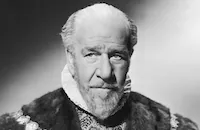Man of Two Worlds

Brief Synopsis
Cast & Crew
J. Walter Ruben
Francis Lederer
Elissa Landi
Henry Stephenson
J. Farrell Mcdonald
Steffi Duna
Film Details
Technical Specs

Synopsis
After returning to his Greenland village with a slain polar bear, the great Eskimo hunter Aigo chooses Guninana as his wife, and the newlyweds live together happily until two British explorers, Sir Basil Pemberton and his assistant, Michael, arrive in the village. As soon as the white men impress Aigo with a few modern innovations, they ask him to join their expedition to capture live polar bears for the London Zoo. Tempted by a photograph of Sir Basil's smiling daughter Joan, the naive Aigo agrees to participate in the gruelling expedition and says goodbye to a pregnant Guninana. While on board Sir Basil's ship, Aigo learns English and is instructed in the ways of "civilized" conduct. Soon after their arrival in the far north, Aigo builds a clever trap and, using himself as bait, captures an enormous polar bear, who mauls Aigo's leg in the process. Before he will allow the ship's doctor to operate on his leg, Aigo insists on gazing at Joan's photograph. Later, while listening to Joan send her father greetings during a Christmas radio broadcast from London, Aigo faints in a trance. When asked about his fainting spell, Aigo explains that, while making a spiritual voyage, he had seen Joan in London, and that earlier, her spirit had helped him to catch the polar bear. Aigo then asks Sir Basil to take him to London to meet Joan in person as payment for his work. In London, Joan, repulsed by his rough manners, remains cool toward Aigo until Sir Basil explains Aigo's belief that she is his old "spiritual" friend. As a favor to her father, Joan agrees to humor Aigo and begins a patronizing flirtation with him. Eventually, Aigo succumbs to an infection and, while recuperating, catches Joan and her boyfriend embracing. Devastated by his discovery, Aigo collapses and is saved only by Joan's reassurances that his vision was a bad dream. Later, however, Joan gives Aigo a glass of whiskey, and suddenly intoxicated, he makes a forceful sexual advance. In her fury, Joan reveals her deception to Aigo, who is then returned to Greenland. There, Aigo, disillusioned and rejected, wanders into a blizzard and is found nearly frozen by his fellow villagers. Finally, Aigo is reborn by the sight of his young son and by the excitement of a village hunt.

Director
J. Walter Ruben
Cast

Francis Lederer

Elissa Landi

Henry Stephenson

J. Farrell Mcdonald

Steffi Duna
Sarah Padden
Walter Byron
Forrester Harvey

Ivan Simpson
Lumsden Hare

Christian Rub
Emil Chautard
Gertrude Wise
Crew
Jimmy Anderson
Pandro S. Berman
Merian C. Cooper
Henry W. Gerrard
Howard J. Green
Al Herman
George Hively
Jack Hively
Capt. Frank E. Kleinschmidt
Ainsworth Morgan
Van Nest Polglase
Max Steiner
John Tribby
Vernon Walker

Film Details
Technical Specs

Articles
Man of Two Worlds -
By Richard Harland Smith

Man of Two Worlds -
Quotes
Trivia
Notes
Steffi Duna, a Hungarian singer and dancer, and Francis Lederer, a Czechoslovakian actor who was well-known in Europe, made their American screen debuts in this film. Several reviewers commented disparagingly about RKO's decision to cast Lederer in an "ugh-ugh" part as a way to cover up his heavy Slavic accent. A Hollywood Reporter news item announced that Marguerite Churchill was to play the feminine lead in the production. According to another Hollywood Reporter news item, after twelve days of shooting, Lederer's co-star still had not been chosen. Motion Picture Herald's "In the Cutting Room" stated that the film story was to begin with "Aigo" as a boy living with his mother, surviving a plague and then growing into manhood. Some of the film's dialogue was written and performed in Eskimo and required a sub-titled English translation. Capt. Frank E. Kleinschmidt, the film's technical advisor, was a well-known Arctic explorer and documentary maker. According to modern sources, the film lost $220,000.














